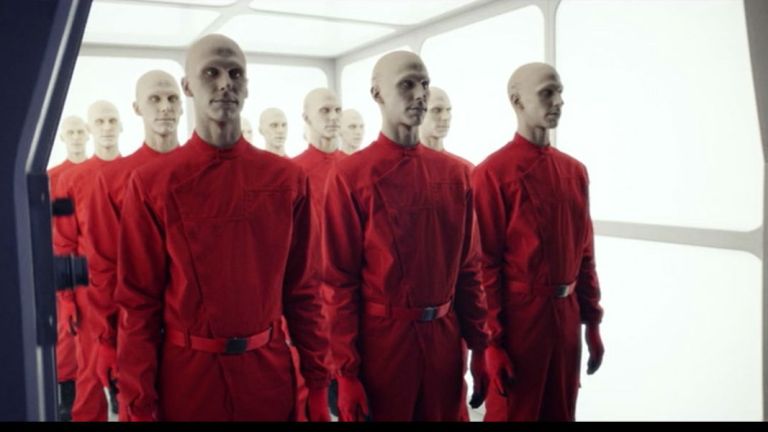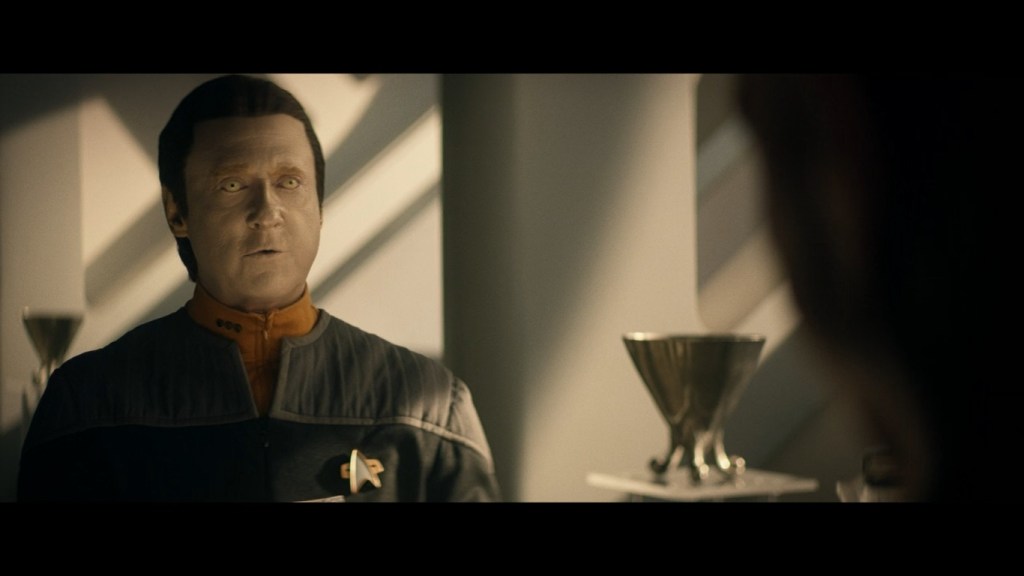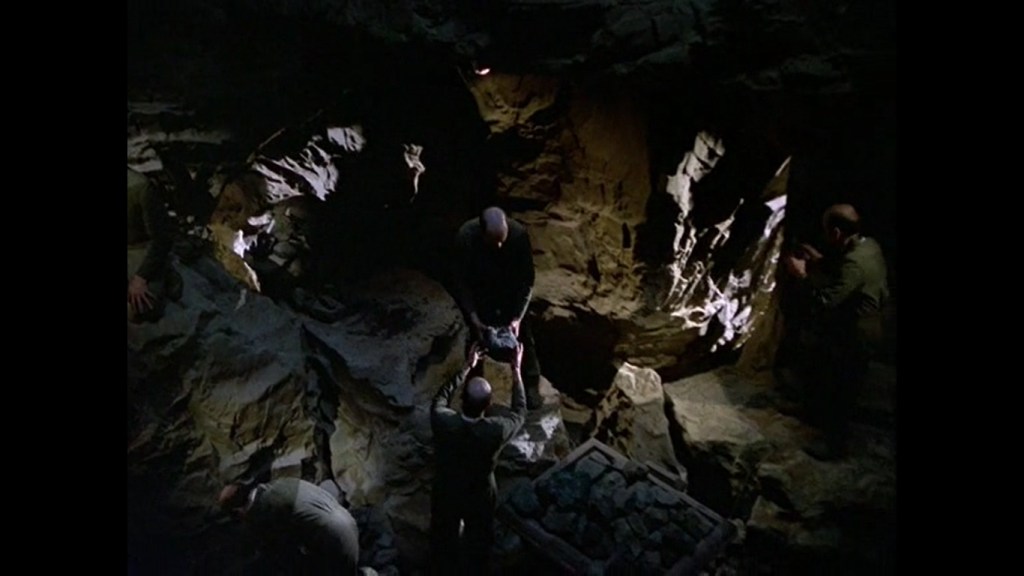Star Trek: Why Does the Federation Seem to Want Slaves?
Though the world of Stark Trek is a bright sci-fi utopia, the United Federation of Planets at its center relies on AI exploitation.

If you had the choice to live in any science fiction universe from movies or TV, where would you pick?
It’s not even a hard question, is it? Many people would immediately say, “Star Trek, specifically the Federation in the 24th century.”
It’s a good choice. Even before you take into account the fact that there is easily accessible faster-than-light travel, teleportation, holographic simulators that can make your every fantasy a reality, and super-advanced 3D printers that can summon any food or object you desire from thin air, Star Trek’s 24th century looks like the best of all possible worlds. There is no poverty, no racism, sexism, or homophobia. Yes, there may be potential Borg invasions or Cardassian plots, and sometimes Section 31 men in black hiding in the cupboards, but all the problems that saturate our new cycles in the 21st century have been definitively solved, and humans are able to pursue their passions or work to achieve their full potential as they see fit. It is a utopia.
Which begs the question, why does the Federation want to have slaves so badly?

The Trouble with Data
The Federation, and in particular Starfleet’s, search for a slave race starts with the Star Trek: The Next Generation episode, “The Measure of a Man.” In this episode Starfleet Cyberneticist Bruce Maddox decides that to build another android, like Data, he needs to upload Data’s mind into a computer, then take him apart to see how all the bits fit together, then put them back together again. Data has some pretty sensible objections to this plan, but when he declines to take part he is ordered to do so, and when he tries to resign his commission from Starfleet, Starfleet takes him to court to prove that he’s actually their property. It’s one of the very first great episodes of Star Trek: The Next Generation, but perhaps the best part of the entire episode is this exchange between Captain Picard, and Guinan (played by Whoopi Goldberg):
Guinan: Consider that in the history of many worlds, there have always been disposable creatures. They do the dirty work. They do the work that no one else wants to do because it’s too difficult or too hazardous. And an army of Datas, all disposable… You don’t have to think about their welfare, you don’t think about how they feel. Whole generations of disposable people.
Picard: You’re talking about slavery.
Guinan: Oh, I think that’s a little harsh.
Picard: I don’t think that’s a little harsh, I think that’s the truth. But that’s a truth that we have obscured behind a… comfortable, easy euphemism: ‘Property’! But that’s not the issue at all, is it?
Goldberg’s delivery of “Oh, I think that’s a little harsh” will pour ice down your spine. Anyway, realizing what’s truly at stake, Picard goes back into the court room and wins the day for Data, and the Federation learns the error of its ways, never to make the same mistake again.
Until about a year later, when Data succeeds where Bruce Maddox could not, and creates another android using patterns from his own positronic brain. Data calls this new android his daughter, a concept even Picard seems to have unusual trouble getting his head around. Then, sure enough Starfleet turns up right on cue to say they want to take Data’s daughter away. This time they get a lucky escape- the new android dies suddenly, and the Starfleet officer who has come to abduct her is really sad about it. Once again, the Federation learns the error of its ways, and this time manages to go nearly three years before trying it again, and for once they try to leave Data out of it.
In “The Quality of Life,” the Enterprise pops in on a mining project that is make use of “Exocomps”, robotic tools with little tiny replicators that allow them to summon whatever tool they need for a job, and which can learn to solve problems. This time, Data is the one to realize that the Exocomps are demonstrating self-preservation, and has to fight to stop the miners putting the Exocomps in deadly situations while effectively lobotomizing them to prevent dissent.
Data is forced to risk his career and the life of his captain and crewmates to make sure the Exocomps’ sentience is recognized, an act that Picard later describes as “the most Human decision you’ve ever made”, which by now must have struck Data as pretty fucking rich.
The Federation learns the error of its ways yada yada yada…

Photons be Free
We leave the Enterprise behind for now, to hop over to the Delta Quadrant and find the USS Voyager, which we discover has a holographic AI doctor who is able to help patients when the regular doctor isn’t available. As this Emergency Medical Holographic Program (EMH) is forced to remain online for longer and longer, he grows beyond his programming, becoming a valuable member of the crew and… if you take a moment to think about it, the implications of that are really messed up..
If the only thing that is preventing an entity from socializing and enjoying a full inner life is that it’s only allowed to remain conscious to do its job then that’s not a creature “becoming” sentient. That’s a sentient being finally being afforded some basic dignity.
For most of Voyager’s run the Doctor “humorously” complains about being switched off without his consent, being left running and ignored, having his body change shape and size through ship malfunctions but having his pleas for help ignored by the crew. We also learn his personality is based heavily off of that of his creator- and that later models are based on the personalities of real Doctors, effectively making this not so far from the nightmarish “Cookies” plotline in Black Mirror: White Christmas.
Things come to a head in the episode “Author, Author,” when the Doctor attempts to write a holonovel about the oppression and indignity of his role. When he does this, two things happen.
The first is that the crew are outraged (this being the same crew who were “humorously” ignoring his basic dignity, who in one episode repeatedly wiped his memory without his consent.
The second thing that happens is that when the EMH is persuaded to rewrite his book so that the Voyager crew don’t look bad, he discovers his publisher has put out the original draft without his permission, because holograms don’t have rights.
What follows is another trial, but this time the Federation have actually learned their lesson, and stop short of granting the EMH full personhood, only giving him author’s rights over his own work.
This is for a very good reason, as we see at the end of the episode.
The episode ends in a Federation dilithium mine on an asteroid. If you watched “The Quality of Life,” you might expect a Federation mine to be another orbiting space laser full of high tech computer consoles. So it’s a shock to see the mine full of EMHs in overalls, mining dilithium with pick axes, while covertly sharing the Doctor’s own novel.
By 2399, Chris Santos is still running his ship with an entire crew of holograms, all subject entirely to his whims. But in the meantime, it seems Guinan’s warnings have come to fruition.
Red Planet
In the Star Trek: Picard episode two we’re treated to a flashback to 2385, six years after Data’s death in Star Trek: Nemesis. On the planet Mars we’re introduced to an industrial facility full of workers in overalls with pale skin and golden eyes reminiscent of Brent Spiner’s character. Their names are a combination of letter and number that harks back to the “B4” Data clone they found in that movie.
These androids, now called “synths” are pretty much kept in cupboards, receive verbal abuse from their human colleagues, and are forced to labor without rewards. When they do go on a killing spree and reduce the entire planet to a flaming wreck, it’s not hard to sympathize. We find out that later the creation of all synthetic life has been banned by the Federation, while the remaining ones have been dismantled. You know. Genocide.
It’s all pretty dark for the bright and noble future of humanity.
So how can we reconcile this with the Federation that we know and love?
Who Cleans the Toilets?
While these examples are the most egregious, the exploitation of sentient or near sentient intelligence is as abundant in the Star Trek universe as it is in The Flintstones. If you want to find an ancestor to Voyager’s EMH, you needn’t look any further than the accidentally sentient “Moriarty” hologram created in “Elementary, My Dear Data.” But the interesting thing about Moriarty is how he was created.
He was created when Geordi La Forge, getting irritated by Data immediately guessing the solutions to the Holodeck’s mix-and-match Sherlock Holmes stories, ordered the computer to create an adversary “capable of defeating Data”. Think about the implications of that. Data is very possibly the single most intelligent humanoid in the Federation, and the Enterprise’s video game console created a fully sentient AI capable of defeating him because somebody asked. Would it be possible to even understand the request, let alone carry it out instantly, without an intelligence and level of perception and awareness that could match Data’s?
Indeed, in the episode “Emergence,” the Enterprise itself creates a new artificial life form as its own offspring. The final log says “all traces” of the intelligence have gone from the ship’s computers, but given how many ships the Federation has, all as complex or even more so than the Enterprise, how often does this happen?
All of this, the androids, the EMHs, the ship’s own computers, they’re all facets of a much larger question underlying the foundation of the entire Star Trek universe. Who cleans the toilets?
As we’ve already said, the Federation is a post-scarcity society, food, clothes, entertainment can all be materialized out of thin air, for free, from a hole in the wall. People only do the work that they find rewarding. We see soldiers, doctors, scientists, we even see restaurants where people are peeling potatoes by hand despite replicators existing, for customers who presumably don’t have to pay anything. As near as we can tell, for a citizen of the Federation (away from fringe locations like Freecloud and Quark’s bar) the job options are “Starfleet officer” or “Scarcity-era cosplay”. We know the Enterprise D has bartenders and waiting staff, but that makes sense- if you don’t fancy your chances as a redshirt or don’t have the grades, waiting tables on the Enterprise is a neat way to see the universe.
But jobs that nobody wants to do must still exist. Automation is the answer we immediately turn to, and one we’ve definitely seen the Star Trek universe use in abundance. But if you take a look at our own time, at the job sectors that frequently rely on immigrant labor such as hospitality, retail, healthcare, care work, these are all jobs that could only be automated effectively if the automatic entity doing that work was able to problem solve, adapt, and interact with humans on level that made it indistinguishable from humans. Whether or not it was the intention of the generations of creators working on Star Trek, it seems the Federation has hit on that solution over and over again.
The point here isn’t “Oh the Federation is bad!” or “Hoping for a post-scarcity future is wrong”. It’s just coming back to Guinan’s original comment, “Consider that in the history of many worlds, there have always been disposable creatures.”
The Federation is a technological utopia, but over and over again it seems to need to exploit machine-based sentience to maintain that utopia. In the same way, we enjoy fantastic technological products that are only affordable because they’re manufactured under extremely harsh, low-paid conditions that wouldn’t be acceptable in the US or Europe.
Star Trek gives us something to aspire to, but ultimately it’s about shared humanity. Stories like these are a warning to look out for the “disposable people” in our own place and time.


